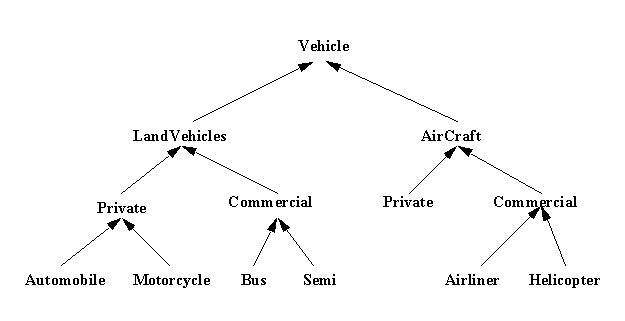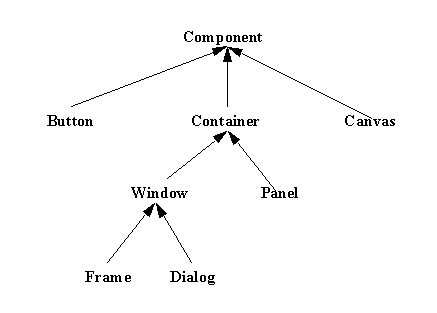|
|
 |
Generalization may be defined as:
This definition shows that generalization is not abstraction although
the two are often confused. Abstraction aims at simplifying the description
of an entity while generalization looks for common properties among these
abstractions.
Generalizations are clearly important and prevalent in many disciplines of study. In science and mathematics, for example, the statements of "laws" and "theorems" are often generalizations - they state some property that holds over a group of things: the more powerful the generalization, the more things to which the generalization applies. The search for the basic forms of matter represents the physicists' quest for a generalization that applies to everything in the physical universe. The biologist's use of generalization is reflected in the organization of plants and animals into the taxonomy whose divisions are kingdom, phylum, class, order, etc.
Generalizations are equally important to software. Much of the effort in building software systems is to allow parts of the system to operate in the most general way possible. In some cases this might mean designing the system so that it can handle any number of things of the same kind. For example, the system might be expected to process any number of lines of input. In other cases the major design problem is how to handle things of different kinds or types. For example, the system might be expect to process input that comes from files of different formats or from both local as well as remote locations. An approach to solving some of these problems is to be able to capture more completely in software the idea of generalization.
One form of generalization is hierarchy. In the case of hierarchy, the commonalities are organized into a tree structured form. At the root of any subtree are found all the attributes and behavior common to all of the descendents of that root. This particular kind of tree structure is referred to as a generalization/specialization hierarchy because the root provides more general properties shared by all its descendents while the descendents typically add specializing properties which make them distinct among their siblings and their siblings' descendents.
A hierarchical organization of components based on a relationship of generalization/specialization is an important device in object-oriented programming. While the power of such an organization can only be fully appreciated after more study, it is useful to at least hint at the role it will play. A generalization and its specializations are often said to be related by an "is-a" relationship. The relationship has this name because it is suggested by phrases such as "an aircraft is a vehicle" and "a lion is a carnivore". In these phrases the characteristics of a specialized entity, the aircraft and lion, are related to the characteristics of a more general category of entities, the vehicle and carnivore categories, respectively. The "is-a" terminology reflects that the specialization has all of the attributes and behavior of the generalization. Thus, an aircraft has all of the properties of vehicle plus additional one that discriminate it as an aircraft apart from other types of vehicles. Similarly, a lion has all of the properties of a carnivore in addition to those that make is uniquely a lion.
A more comprehensive intuitive example of a generalization/specialization
hierarchy is one that organizes and relates the characteristics of different
types of vehicles. The diagram in Figure 1.6.1 illustrates a possible hierarchical
structure for vehicles. The arrows in this diagram represent the "is-a"
relation. For example, the arrow connecting the categories Aircraft and
Vehicle is read as "Aircraft is a kind of Vehicle." The general concept
of Vehicle is the root of the hierarchy. Properties shared by all vehicles
might include the manufacturer's name, the type of fuel required, and the
maximum speed. Two distinct groups of vehicles are those intended for use
on land, LandVehicles, and those designed to fly, Aircraft. Properties
common to all land vehicles are the number of axles, and the vehicle identification
number. While these properties make sense for LandVehicles, they are not
relevant to Aircraft. Aircraft properties, however, might include a transponder
signature, and a tail number. Both LandVehicles and Aircraft can be divided
into Private and Commercial categories. Things in the Private category
have a person-owner attribute while those in the Commerical category have
a company-owner attribute. Various specific types of vehicles are shown
for the LandVehicles categories and for the commerical subcategory of Aircraft.
|
|
 |
Another example of a generalization/specialization hierarchy, this time from the domain of graphical user interfaces, is shown in Figure 1.6.2. The most general element, Component, has attributes of location (coordinates denoting where the component appears on the screen) and shape (height and width), and a behavior that allows the component to be repositioned and resized. Specialized kinds of Components include an area for drawing graphical shapes (Canvas), an interactive element for user control (Button), and a general collection of components (Container). Two specialized kinds of Containers are a Window, a Container that has a visible representation on the screen, and a Panel, a Container that maintains an arrangement of other Components. The Frame is a Window with a border and a Dialog is a Window specialized for the purposes of creating a text-oriented interaction with the user.
|
A Generalization/Specialization Hierarchy |
|---|
 |
The notion of hierarchy in object-oriented programming can be defined as follows:
A generalization/specialization hierarchy serves at least four major
purposes. First, it provides a form of knowledge representation. A higher
(more generalized) level in the hierarchy encodes an understanding of the
general attributes and behavior possessed by all of its specialized descendents.
Thus, it is possible to make statements such as: "All windows can be resized."
and "All windows can be repositioned.". Second, the names of the intermediate
levels in the hierarchy provide a vocabulary that can be used among developers
and between developers and domain experts (those knowledgeable about the
application domain but not necessarily about computing). This vocabulary
allows discussions to be less ambiguous because the terms in the vocabulary
identify specific, clearly defined concepts. Third, the hierarchy can be
extended by adding new specializations at any level. These additions are
easier to make because they occur within an existing framework that defines
some, perhaps, many of their attributes and behavior. For example, to add
a new specialized kind of Panel, it is not necessary to redefine all of
the attributes and behavior already defined in Container, Component, and
Panel; these are assumed to be part of the more generalized nature of the
specialized Panel being added. Fourth, new attributes and behavior can
be added easily to the proper subset of specializations. For example, any
new attribute or behavior that might be needed for all containers can be
added to the Container class. These additional attributes or behavior are
then "automatically" part of all specialized kinds of Containers, but not
of anything else.